Ultrafiltration Market
Ultrafiltration Market Size and Share Forecast Outlook 2025 to 2035
Ultrafiltration market is projected to grow from USD 2.4 billion in 2025 to USD 3.9 billion by 2035, at a CAGR of 5.0%. Hollow Fiber will dominate with a 60.0% market share, while municipal will lead the end-use segment with a 45.0% share.
Ultrafiltration Market Forecast and Outlook 2025 to 2035
The ultrafiltration market stands at the threshold of a decade-long expansion trajectory that promises to reshape filtration technology and water processing application solutions. The market's journey from USD 2.4 billion in 2025 to USD 3.9 billion by 2035 represents substantial growth, The market will rise at a CAGR of 5.0% which demonstrating the accelerating adoption of advanced membrane processing technology and application optimization across municipal water facilities, industrial operations, and food processing sectors.
The first half of the decade (2025-2030) will witness the market climbing from USD 2.4 billion to approximately USD 3.1 billion, adding USD 700.0 million in value, which constitutes 47% of the total forecast growth period. This phase will be characterized by the rapid adoption of hollow fiber membrane systems, driven by increasing water treatment volumes and the growing need for advanced filtration processing solutions worldwide. Enhanced membrane capabilities and automated quality control systems will become standard expectations rather than premium options.
The latter half (2030-2035) will witness continued growth from USD 3.1 billion to USD 3.9 billion, representing an addition of USD 800.0 million or 53% of the decade's expansion. This period will be defined by mass market penetration of tubular processing technologies, integration with comprehensive water management platforms, and seamless compatibility with existing filtration infrastructure. The market trajectory signals fundamental shifts in how treatment facilities approach membrane production and water management, with participants positioned to benefit from growing demand across multiple membrane types and application segments.
Quick Stats for Ultrafiltration Market
- Ultrafiltration Market Value (2025): USD 2.4 billion
- Ultrafiltration Market Forecast Value (2035): USD 3.9 billion
- Ultrafiltration Market Forecast CAGR: 5.0%
- Leading Module Type in Ultrafiltration Market: Hollow Fiber (60%)
- Key Growth Regions in Ultrafiltration Market: East Asia, Europe, and North America
- Top Players in Ultrafiltration Market: DuPont, Suez, Toray, Pentair, 3M
- Where revenue comes from - Now Vs Next (Industry-level view)
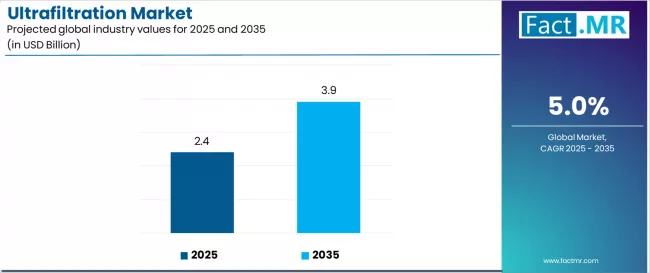
| Period | Primary Revenue Buckets | Share | Notes |
|---|---|---|---|
| Today | Hollow fiber membrane production | 60% | Volume-driven, municipal-grade processing |
| Tubular processing | 25% | Industrial focus, value-added applications | |
| Municipal applications | 45% | Large-scale distribution, performance-sensitive | |
| Industrial production | 35% | Premium applications, treatment requirements | |
| Future (3-5 yrs) | Advanced hollow fiber systems | 58-62% | Technology enhancement, efficiency gains |
| Tubular innovations | 27-30% | Industrial differentiation, application expansion | |
| Custom membrane solutions | 12-15% | Industry-specific formulations | |
| Food & beverage optimization | 17-20% | Processing applications, filtration efficiency | |
| Ceramic membrane applications | 22-25% | Advanced materials, new markets | |
| Digital monitoring and control | 4-6% | Supply chain optimization, water management |
Ultrafiltration Market Key Takeaways
At-a-Glance Metrics
| Metric | Value |
|---|---|
| Market Value (2025) → | USD 2.4 billion |
| Market Forecast (2035) ↑ | USD 3.9 billion |
| Growth Rate ★ | 5.0% CAGR |
| Leading Module → | Hollow Fiber |
| Primary Application → | Municipal Segment |
The market demonstrates strong fundamentals with hollow fiber membrane systems capturing a dominant share through advanced filtration capabilities and municipal water optimization. Municipal applications drive primary demand, supported by increasing membrane processing requirements and water treatment capacity development. Geographic expansion remains concentrated in developed markets with established water infrastructure, while emerging economies show accelerating adoption rates driven by local water treatment initiatives and rising quality standards.
Imperatives for Stakeholders in Ultrafiltration Market
Design for application versatility, not just filtration volume
- Offer application development packages: membrane equipment + application testing + documentation + trained technicians + technical support.
- Preconfigured workflows: filtration protocols, membrane changeover procedures, batch records, and digital traceability on filtration runs.
Filtration technology readiness
- Real-time quality monitoring analytics, predictive maintenance capabilities, and smart membrane integration (MES connectivity, flow tracking systems).
Quality-by-design approach
- Automated membrane control systems, real-time quality mechanisms, statistical process control integration, and paperless batch documentation.
Value-based pricing models
- Clear base filtration price + transparent service tiers (application support, membrane availability, performance guarantees); subscriptions for digital services and analytics.
Segmental Analysis
Primary Classification: The market segments by module type into hollow fiber, tubular, plate & frame, and others variants, representing the evolution from basic filtration methods to specialized membrane solutions for comprehensive municipal and industrial water optimization.
Secondary Classification: End-use segmentation divides the market into municipal (45%), industrial (35%), food & beverage (15%), and others (5%) sectors, reflecting distinct requirements for application performance, operational efficiency, and facility processing standards.
Material Classification: Product structure covers polymer (80%) and ceramic (20%) materials, demonstrating market preference for polymer formulations while emerging ceramic materials show growth potential.
Regional Classification: Geographic distribution covers major regions with East Asia leading adoption while Western Europe and North America show strong market presence driven by water treatment expansion programs.
The segmentation structure reveals technology progression from standard filtration methods toward specialized membrane systems with enhanced application consistency and filtration capabilities, while application diversity spans from municipal water facilities to industrial operations requiring precise membrane solutions.
By Module Type, the Hollow Fiber Segment Accounts for Dominant Market Share
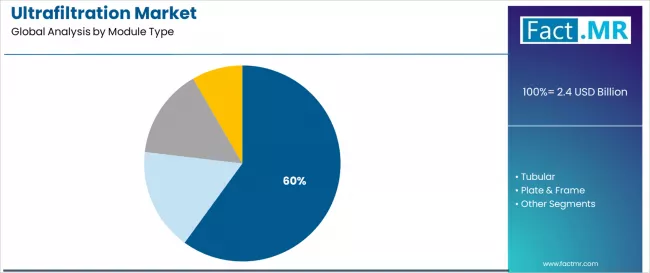
Market Position: Hollow Fiber systems command the leading position in the ultrafiltration market with 60% market share through advanced membrane features, including superior functionality characteristics, operational efficiency, and municipal water optimization that enable treatment facilities to achieve optimal consistency across diverse filtration processing and water applications.
Value Drivers: The segment benefits from water facility preference for reliable membrane systems that provide consistent performance characteristics, reduced filtration complexity, and operational efficiency optimization without requiring significant infrastructure modifications. Advanced design features enable automated quality control systems, flow consistency, and integration with existing membrane equipment, where operational performance and regulatory compliance represent critical facility requirements.
Competitive Advantages: Hollow Fiber systems differentiate through proven operational reliability, consistent membrane characteristics, and integration with automated water processing systems that enhance facility effectiveness while maintaining optimal quality standards for diverse municipal water and industrial applications.
Key market characteristics:
- Advanced membrane designs with optimized functionality configuration and operational efficiency capabilities
- Enhanced filtration effectiveness, enabling 95-98% separation consistency with reliable quality performance
- Municipal water compatibility, including automated quality systems, monitoring integration, and process optimization for membrane production
Tubular Systems Show Industrial Market Growth
Tubular systems maintain a 25% market position in the ultrafiltration market due to their enhanced functional properties and industrial application characteristics. These systems appeal to facilities requiring specialized performance with premium positioning for industrial processing applications. Market growth is driven by industrial segment expansion, emphasizing functional membrane solutions and operational efficiency through optimized filtration designs.
Plate & Frame Systems Show Specialized Growth
Plate & Frame account for 10% market share, including specialized membrane manufacturing, processing operations, and applications requiring efficient filtration solutions for operational optimization and water enhancement.
By End-Use, the Municipal Segment Shows Market Leadership
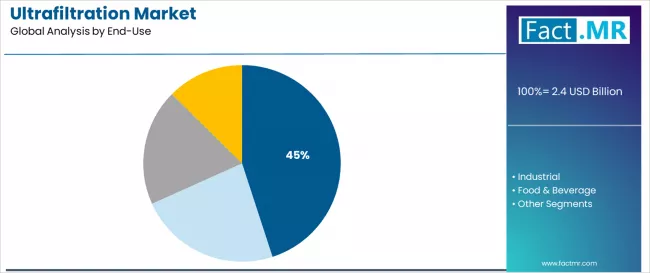
Market Context: Municipal applications demonstrate market leadership in the ultrafiltration market with 45% share due to widespread adoption of membrane processing systems and increasing focus on municipal water optimization, operational cost efficiency, and facility processing applications that maximize water quality while maintaining treatment standards.
Appeal Factors: Municipal operators prioritize membrane consistency, filtration efficiency, and integration with existing water treatment infrastructure that enables coordinated membrane operations across multiple treatment runs. The segment benefits from substantial municipal investment and modernization programs that emphasize the acquisition of advanced membrane systems for water optimization and treatment efficiency applications.
Growth Drivers: Municipal water expansion programs incorporate ultrafiltration as standard treatment for water operations, while municipal development growth increases demand for consistent membrane capabilities that comply with quality standards and minimize operational complexity.
Application dynamics include:
- Strong growth in municipal water treatment and processing requiring advanced membrane capabilities
- Increasing adoption in water optimization and operational efficiency applications for membrane processors
- Rising integration with automated quality systems for operational optimization and compliance assurance
Industrial Applications Maintain Strong Demand
Industrial applications capture 35% market share through comprehensive processing requirements in manufacturing facilities, development operations, and industrial applications. These facilities demand reliable membrane systems capable of operating with diverse formulations while providing effective processing integration and operational performance capabilities.
Food & Beverage Applications Show Processing Growth
Food & Beverage applications account for 15% market share, including food processing membrane manufacturing, beverage operations, and processing requiring efficient membrane solutions for operational optimization and food enhancement.
By Material, the Polymer Segment Shows Market Leadership
Polymer material applications demonstrate market leadership with 80% share through established processing characteristics and membrane advantages that enable comprehensive filtration coverage and material availability across diverse processing sectors.
What are the Drivers, Restraints, and Key Trends of the Ultrafiltration Market?
| Category | Factor | Impact | Why It Matters |
|---|---|---|---|
| Driver | Water treatment expansion & quality demand (regulatory trends, infrastructure growth) | ★★★★★ | Large-scale water treatment requires efficient, reliable membrane solutions with consistent quality and functional performance across treatment applications. |
| Driver | Industrial application diversification & process development | ★★★★★ | Drives demand for advanced membrane solutions and specialized filtration capabilities; suppliers providing application development gain competitive advantage. |
| Driver | Quality water requirements & regulatory compliance | ★★★★★ | Water processors need compliant, efficient membrane solutions; demand for certified membrane formats expanding addressable market segments. |
| Restraint | Membrane cost volatility & material supply fluctuations | ★★★★☆ | Small membrane processors face margin pressure; increases cost sensitivity and affects processing consistency in volatile material markets. |
| Restraint | Processing complexity & equipment investment requirements | ★★★☆☆ | Quality-focused applications face challenges with membrane adaptation and capital requirements, limiting adoption in cost-sensitive segments. |
| Trend | Food & beverage integration & processing applications | ★★★★★ | Growing demand for food processing membrane applications; processing compatibility becomes core value proposition in food treatment segments. |
| Trend | Asian market expansion & regional water growth | ★★★★☆ | Regional water development drives demand for local membrane solutions; regional integration capabilities drive competition toward localization. |
Analysis of the Ultrafiltration Market by Key Country
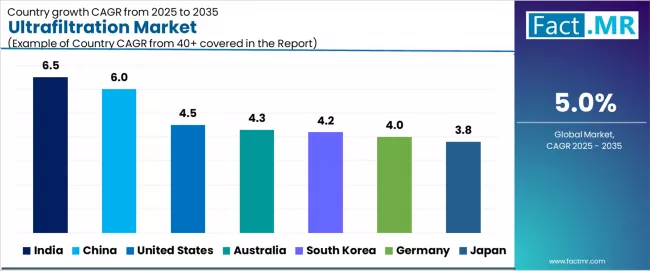
The ultrafiltration market demonstrates varied regional dynamics with growth leaders including India (6.5% growth rate) and China (6.0% growth rate) driving expansion through water treatment initiatives and membrane capacity development. Steady Performers encompass United States (4.5% growth rate), Australia (4.3% growth rate), and South Korea (4.2% growth rate), benefiting from established water industries and advanced technology adoption. Mature Markets feature Germany (4.0% growth rate) and Japan (3.8% growth rate), where membrane technology advancement and quality standardization requirements support consistent growth patterns.
Regional synthesis reveals South Asian and East Asian markets leading adoption through membrane expansion and water development, while Western countries maintain steady expansion supported by technology advancement and regulatory standardization requirements. Emerging markets show strong growth driven by municipal applications and membrane integration trends.
| Region/Country | 2025-2035 Growth | How to win | What to watch out |
|---|---|---|---|
| India | 6.5% | Focus on cost-effective membrane solutions | Supply chain challenges; quality standardization |
| China | 6.0% | Lead with high-volume treatment systems | Environmental regulations; processing complexity |
| United States | 4.5% | Value-oriented municipal models | Technology dependencies; cost fluctuations |
| Australia | 4.3% | Offer premium water systems | Over-regulation; processing requirements |
| South Korea | 4.2% | Push industrial application solutions | Market saturation; membrane costs |
| Germany | 4.0% | Provide regulatory compliant applications | Processing regulations; treatment requirements |
| Japan | 3.8% | Premium technology positioning | Processing precision; market maturity |
India Drives Fastest Market Growth
India establishes fastest market growth through aggressive water treatment programs and comprehensive membrane capacity development, integrating advanced ultrafiltration processing as standard components in municipal water and industrial application installations. The country's 6.5% growth rate reflects government initiatives promoting water treatment modernization and infrastructure development capabilities that mandate the use of advanced membrane systems in water facilities. Growth concentrates in major water treatment hubs, including Maharashtra, Karnataka, and Tamil Nadu, where membrane technology development showcases integrated processing systems that appeal to operators seeking advanced water optimization capabilities and quality management applications.
Indian manufacturers are developing cost-effective membrane solutions that combine domestic water advantages with advanced operational features, including automated quality systems and enhanced consistency capabilities. Distribution channels through water equipment suppliers and municipal service distributors expand market access, while government support for water industry development supports adoption across diverse treatment segments.
Strategic Market Indicators:
- Water treatment facilities leading adoption with 85% deployment rate in membrane processing and municipal water sectors
- Government water programs providing substantial funding for domestic processing technology development
- Local water processors capturing 70% market share through competitive sourcing and localized processing support
- Export market development for cost-effective membrane solutions targeting emerging water treatment markets
China Emerges as High-Volume Market
In Guangdong, Jiangsu, and Shandong provinces, water treatment facilities and processing plants are implementing advanced ultrafiltration processing as standard equipment for water optimization and municipal application enhancement, driven by increasing government water investment and infrastructure modernization programs that emphasize the importance of membrane processing capabilities. The market holds a 6.0% growth rate, supported by government water initiatives and processing infrastructure development programs that promote advanced membrane systems for water facilities. Chinese operators are adopting membrane systems that provide consistent operational performance and quality compliance features, particularly appealing in water regions where processing efficiency and water standards represent critical operational requirements.
Market expansion benefits from growing water processing capabilities and municipal integration agreements that enable domestic production of advanced membrane systems for water applications. Technology adoption follows patterns established in water equipment, where efficiency and performance drive procurement decisions and operational deployment.
United States Shows Municipal Leadership
United States establishes municipal leadership through comprehensive water programs and established regulatory infrastructure, integrating ultrafiltration across municipal water and industrial applications. The country's 4.5% growth rate reflects mature water industry relationships and established membrane adoption that supports widespread use of membrane systems in municipal water and treatment facilities. Growth concentrates in major water centers, including Texas, California, and Florida, where membrane technology showcases mature processing deployment that appeals to processors seeking proven regulatory capabilities and operational efficiency applications.
American processors leverage established distribution networks and comprehensive regulatory capabilities, including application development programs and technical support that create customer relationships and operational advantages. The market benefits from mature water safety standards and regulatory requirements that mandate membrane system use while supporting technology advancement and operational optimization.
Australia Shows Water Technology Leadership
Australia establishes water technology leadership through comprehensive water treatment programs and established infrastructure, integrating ultrafiltration across municipal water and industrial applications. The country's 4.3% growth rate reflects advanced water industry relationships and established membrane adoption that supports widespread use of membrane systems in water treatment and processing facilities. Growth concentrates in major water centers, including New South Wales, Victoria, and Queensland, where membrane technology showcases mature processing deployment that appeals to processors seeking proven water management capabilities and operational efficiency applications.
Australian processors leverage established water networks and comprehensive treatment capabilities, including application development programs and technical support that create customer relationships and operational advantages. The market benefits from advanced water management standards and regulatory requirements that mandate membrane system use while supporting technology advancement and operational optimization.
South Korea Shows Industrial Market Development
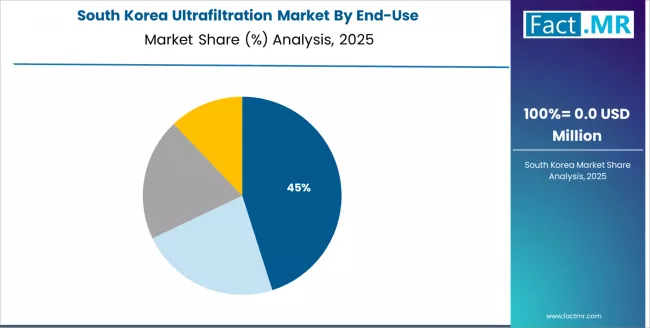
South Korea establishes industrial market development through comprehensive water modernization and technology integration, integrating ultrafiltration systems across industrial manufacturing and specialty water applications. The country's 4.2% growth rate reflects growing water investment and increasing adoption of membrane processing that supports expanding use of membrane systems in Korean water facilities. Growth concentrates in major industrial areas, including Seoul metropolitan area, Busan, and Incheon, where membrane technology development showcases integrated processing systems that appeal to Korean processors seeking advanced industrial solutions with processing efficiency compatibility.
Korean processors focus on maintaining quality standards while adopting industrial processing efficiency, creating demand for systems that balance performance with operational advantages. The market benefits from strong water infrastructure and growing export opportunities that support processing technology adoption while maintaining quality standards important to Korean industrial applications.
Germany Shows Regulatory Compliance Market Development
Advanced water technology market in Germany demonstrates sophisticated ultrafiltration processing deployment with documented operational effectiveness in municipal applications and water facilities through integration with existing quality systems and processing infrastructure. The country leverages engineering expertise in membrane technology and quality systems integration to maintain a 4.0% growth rate. Water centers, including North Rhine-Westphalia, Bavaria, and Baden-Württemberg, showcase premium installations where membrane systems integrate with comprehensive water platforms and facility management systems to optimize water operations and quality effectiveness.
German manufacturers prioritize system precision and EU compliance in membrane equipment development, creating demand for premium systems with advanced features, including facility monitoring integration and automated quality systems. The market benefits from established membrane technology infrastructure and willingness to invest in advanced membrane technologies that provide long-term operational benefits and compliance with international water standards.
Japan Demonstrates Premium Technology Focus
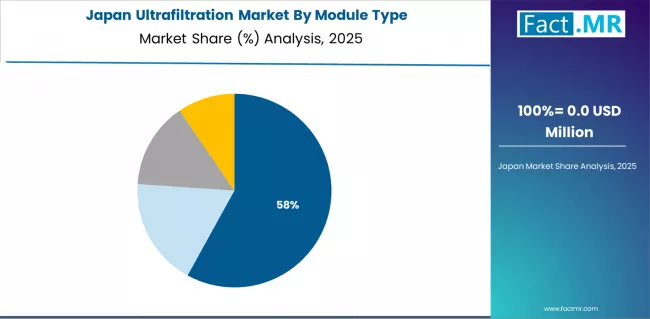
Advanced water technology market in Japan demonstrates sophisticated ultrafiltration processing with documented operational effectiveness in premium municipal applications and modern water facilities through integration with existing quality systems and processing infrastructure. The country maintains a 3.8% growth rate, leveraging traditional quality expertise and precision systems integration in membrane technology. Water centers, including Tokyo, Osaka, and Nagoya, showcase premium installations where membrane systems integrate with traditional quality platforms and modern facility management systems to optimize water operations and maintain processing quality profiles.
Japanese manufacturers prioritize membrane precision and quality consistency in processing development, creating demand for premium systems with advanced features, including quality monitoring and automated membrane systems. The market benefits from established quality infrastructure and commitment to processing standards that provide long-term operational benefits and compliance with traditional quality water methods.
Europe Market Split by Country
The European ultrafiltration market is projected to grow strongly with regional distribution across major economies. Germany is expected to maintain its leadership position with USD 550.0 million in 2025, supported by its advanced membrane infrastructure and major water treatment centers.
United Kingdom follows with USD 380.0 million, driven by comprehensive membrane programs and water technology development initiatives. France holds USD 320.0 million through specialized membrane applications and regulatory compliance requirements. Italy commands USD 260.0 million, while Spain accounts for USD 210.0 million in 2025. The rest of Europe region maintains USD 680.0 million, attributed to increasing membrane processing adoption in Nordic countries and emerging water facilities implementing membrane modernization programs.
Competitive Landscape of the Ultrafiltration Market
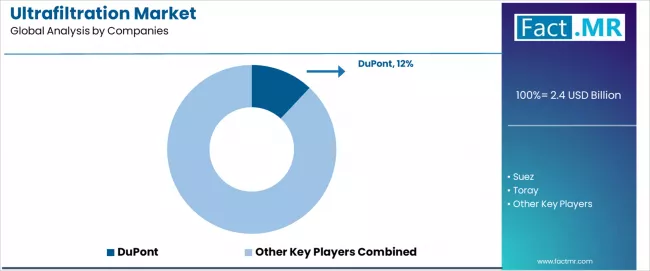
- Structure: ~12-15 credible players; top 3-5 hold ~40-45% by revenue.
- Leadership is maintained through: supply chain control, membrane innovation, and application consistency (functionality retention + cost efficiency + application versatility).
- What's commoditizing: basic membrane processing methods and standard module packaging.
- Margin Opportunities: custom application formulations, technical development, and integration into customer supply chains (inventory management, just-in-time delivery).
| Stakeholder | What they actually control | Typical strengths | Typical blind spots |
|---|---|---|---|
| Global platforms | Distribution reach, deep product catalogs, membrane facilities | Broad availability, proven reliability, multi-region support | Membrane refresh cycles; customer lock-in dependency |
| Technology innovators | R&D capabilities; advanced membrane systems; digital interfaces | Latest membrane first; attractive ROI on high-volume processing | Service density outside core regions; customization complexity |
| Regional specialists | Local sourcing, fast delivery, nearby technical support | "Close to site" support; pragmatic pricing; local regulations | Technology gaps; talent retention in membrane processing |
| Quality-focused ecosystems | Application consistency, technical support, membrane sourcing | Lowest application variation; comprehensive support | Membrane costs if overpromised; technology obsolescence |
| Application specialists | Specialized formulations, custom solutions, technical development | Win specialized applications; flexible membrane processing | Scalability limitations; narrow market focus |
Key Players in the Ultrafiltration Market
- DuPont
- Suez
- Toray
- Pentair
- 3M
- Koch Membrane
- Asahi Kasei
- Pall Corp
- Nitto Denko
- GEA
- Parker Hannifin
- MANN+HUMMEL
- Mitsubishi Chemical
- Wabag
- Synder Filtration
Scope of the Report
| Items | Values |
|---|---|
| Quantitative Units (2025) | USD 2.4 billion |
| Module Type | Hollow Fiber, Tubular, Plate & Frame, Others |
| End Use | Municipal, Industrial, Food & Beverage, Others |
| Material | Polymer, Ceramic |
| Regions Covered | East Asia, Western Europe, South Asia Pacific, North America, Latin America, Middle East & Africa |
| Countries Covered | China, Germany, United States, Japan, India, South Korea, Australia, France, United Kingdom, and 30+ additional countries |
| Key Companies Profiled | DuPont, Suez, Toray, Pentair, 3M, Koch Membrane, Asahi Kasei, Pall Corp, Nitto Denko, GEA, Parker Hannifin |
| Additional Attributes | Dollar sales by module type, end-use categories, and material segments, regional adoption trends across East Asia, Western Europe, and South Asia Pacific, competitive landscape with membrane manufacturers and water treatment suppliers, processor preferences for application consistency and membrane reliability, integration with water platforms and quality monitoring systems, innovations in membrane technology and application enhancement, and development of advanced membrane solutions with enhanced performance and water optimization capabilities. |
Ultrafiltration Market by Segments
-
Module Type :
- Hollow Fiber
- Tubular
- Plate & Frame
- Others
-
End Use :
- Municipal
- Industrial
- Food & Beverage
- Others
-
Material :
- Polymer
- Ceramic
-
Region :
- East Asia
- China
- Japan
- South Korea
- South Asia Pacific
- India
- ASEAN
- Australia & New Zealand
- Rest of South Asia Pacific
- Western Europe
- Germany
- France
- United Kingdom
- Italy
- Spain
- Rest of Western Europe
- North America
- United States
- Canada
- Mexico
- Latin America
- Brazil
- Rest of Latin America
- Middle East & Africa
- GCC Countries
- South Africa
- Rest of Middle East & Africa
- East Asia
Table of Content
- Executive Summary
- Global Market Outlook
- Demand to side Trends
- Supply to side Trends
- Technology Roadmap Analysis
- Analysis and Recommendations
- Market Overview
- Market Coverage / Taxonomy
- Market Definition / Scope / Limitations
- Market Background
- Market Dynamics
- Drivers
- Restraints
- Opportunity
- Trends
- Scenario Forecast
- Demand in Optimistic Scenario
- Demand in Likely Scenario
- Demand in Conservative Scenario
- Opportunity Map Analysis
- Product Life Cycle Analysis
- Supply Chain Analysis
- Investment Feasibility Matrix
- Value Chain Analysis
- PESTLE and Porter’s Analysis
- Regulatory Landscape
- Regional Parent Market Outlook
- Production and Consumption Statistics
- Import and Export Statistics
- Market Dynamics
- Global Market Analysis 2020 to 2024 and Forecast, 2025 to 2035
- Historical Market Size Value (USD Million) Analysis, 2020 to 2024
- Current and Future Market Size Value (USD Million) Projections, 2025 to 2035
- Y to o to Y Growth Trend Analysis
- Absolute $ Opportunity Analysis
- Global Market Pricing Analysis 2020 to 2024 and Forecast 2025 to 2035
- Global Market Analysis 2020 to 2024 and Forecast 2025 to 2035, By Module Type
- Introduction / Key Findings
- Historical Market Size Value (USD Million) Analysis By Module Type , 2020 to 2024
- Current and Future Market Size Value (USD Million) Analysis and Forecast By Module Type , 2025 to 2035
- Hollow Fiber
- Tubular
- Plate & Frame
- Others
- Y to o to Y Growth Trend Analysis By Module Type , 2020 to 2024
- Absolute $ Opportunity Analysis By Module Type , 2025 to 2035
- Global Market Analysis 2020 to 2024 and Forecast 2025 to 2035, By End-Use
- Introduction / Key Findings
- Historical Market Size Value (USD Million) Analysis By End-Use, 2020 to 2024
- Current and Future Market Size Value (USD Million) Analysis and Forecast By End-Use, 2025 to 2035
- Municipal
- Industrial
- Food & Beverage
- Others
- Y to o to Y Growth Trend Analysis By End-Use, 2020 to 2024
- Absolute $ Opportunity Analysis By End-Use, 2025 to 2035
- Global Market Analysis 2020 to 2024 and Forecast 2025 to 2035, By Region
- Introduction
- Historical Market Size Value (USD Million) Analysis By Region, 2020 to 2024
- Current Market Size Value (USD Million) Analysis and Forecast By Region, 2025 to 2035
- North America
- Latin America
- Western Europe
- Eastern Europe
- East Asia
- South Asia and Pacific
- Middle East & Africa
- Market Attractiveness Analysis By Region
- North America Market Analysis 2020 to 2024 and Forecast 2025 to 2035, By Country
- Historical Market Size Value (USD Million) Trend Analysis By Market Taxonomy, 2020 to 2024
- Market Size Value (USD Million) Forecast By Market Taxonomy, 2025 to 2035
- By Country
- USA
- Canada
- Mexico
- By Module Type
- By End-Use
- By Country
- Market Attractiveness Analysis
- By Country
- By Module Type
- By End-Use
- Key Takeaways
- Latin America Market Analysis 2020 to 2024 and Forecast 2025 to 2035, By Country
- Historical Market Size Value (USD Million) Trend Analysis By Market Taxonomy, 2020 to 2024
- Market Size Value (USD Million) Forecast By Market Taxonomy, 2025 to 2035
- By Country
- Brazil
- Chile
- Rest of Latin America
- By Module Type
- By End-Use
- By Country
- Market Attractiveness Analysis
- By Country
- By Module Type
- By End-Use
- Key Takeaways
- Western Europe Market Analysis 2020 to 2024 and Forecast 2025 to 2035, By Country
- Historical Market Size Value (USD Million) Trend Analysis By Market Taxonomy, 2020 to 2024
- Market Size Value (USD Million) Forecast By Market Taxonomy, 2025 to 2035
- By Country
- Germany
- UK
- Italy
- Spain
- France
- Nordic
- BENELUX
- Rest of Western Europe
- By Module Type
- By End-Use
- By Country
- Market Attractiveness Analysis
- By Country
- By Module Type
- By End-Use
- Key Takeaways
- Eastern Europe Market Analysis 2020 to 2024 and Forecast 2025 to 2035, By Country
- Historical Market Size Value (USD Million) Trend Analysis By Market Taxonomy, 2020 to 2024
- Market Size Value (USD Million) Forecast By Market Taxonomy, 2025 to 2035
- By Country
- Russia
- Poland
- Hungary
- Balkan & Baltic
- Rest of Eastern Europe
- By Module Type
- By End-Use
- By Country
- Market Attractiveness Analysis
- By Country
- By Module Type
- By End-Use
- Key Takeaways
- East Asia Market Analysis 2020 to 2024 and Forecast 2025 to 2035, By Country
- Historical Market Size Value (USD Million) Trend Analysis By Market Taxonomy, 2020 to 2024
- Market Size Value (USD Million) Forecast By Market Taxonomy, 2025 to 2035
- By Country
- China
- Japan
- South Korea
- By Module Type
- By End-Use
- By Country
- Market Attractiveness Analysis
- By Country
- By Module Type
- By End-Use
- Key Takeaways
- South Asia and Pacific Market Analysis 2020 to 2024 and Forecast 2025 to 2035, By Country
- Historical Market Size Value (USD Million) Trend Analysis By Market Taxonomy, 2020 to 2024
- Market Size Value (USD Million) Forecast By Market Taxonomy, 2025 to 2035
- By Country
- India
- ASEAN
- Australia & New Zealand
- Rest of South Asia and Pacific
- By Module Type
- By End-Use
- By Country
- Market Attractiveness Analysis
- By Country
- By Module Type
- By End-Use
- Key Takeaways
- Middle East & Africa Market Analysis 2020 to 2024 and Forecast 2025 to 2035, By Country
- Historical Market Size Value (USD Million) Trend Analysis By Market Taxonomy, 2020 to 2024
- Market Size Value (USD Million) Forecast By Market Taxonomy, 2025 to 2035
- By Country
- Kingdom of Saudi Arabia
- Other GCC Countries
- Turkiye
- South Africa
- Other African Union
- Rest of Middle East & Africa
- By Module Type
- By End-Use
- By Country
- Market Attractiveness Analysis
- By Country
- By Module Type
- By End-Use
- Key Takeaways
- Key Countries Market Analysis
- USA
- Pricing Analysis
- Market Share Analysis, 2024
- By Module Type
- By End-Use
- Canada
- Pricing Analysis
- Market Share Analysis, 2024
- By Module Type
- By End-Use
- Mexico
- Pricing Analysis
- Market Share Analysis, 2024
- By Module Type
- By End-Use
- Brazil
- Pricing Analysis
- Market Share Analysis, 2024
- By Module Type
- By End-Use
- Chile
- Pricing Analysis
- Market Share Analysis, 2024
- By Module Type
- By End-Use
- Germany
- Pricing Analysis
- Market Share Analysis, 2024
- By Module Type
- By End-Use
- UK
- Pricing Analysis
- Market Share Analysis, 2024
- By Module Type
- By End-Use
- Italy
- Pricing Analysis
- Market Share Analysis, 2024
- By Module Type
- By End-Use
- Spain
- Pricing Analysis
- Market Share Analysis, 2024
- By Module Type
- By End-Use
- France
- Pricing Analysis
- Market Share Analysis, 2024
- By Module Type
- By End-Use
- India
- Pricing Analysis
- Market Share Analysis, 2024
- By Module Type
- By End-Use
- ASEAN
- Pricing Analysis
- Market Share Analysis, 2024
- By Module Type
- By End-Use
- Australia & New Zealand
- Pricing Analysis
- Market Share Analysis, 2024
- By Module Type
- By End-Use
- China
- Pricing Analysis
- Market Share Analysis, 2024
- By Module Type
- By End-Use
- Japan
- Pricing Analysis
- Market Share Analysis, 2024
- By Module Type
- By End-Use
- South Korea
- Pricing Analysis
- Market Share Analysis, 2024
- By Module Type
- By End-Use
- Russia
- Pricing Analysis
- Market Share Analysis, 2024
- By Module Type
- By End-Use
- Poland
- Pricing Analysis
- Market Share Analysis, 2024
- By Module Type
- By End-Use
- Hungary
- Pricing Analysis
- Market Share Analysis, 2024
- By Module Type
- By End-Use
- Kingdom of Saudi Arabia
- Pricing Analysis
- Market Share Analysis, 2024
- By Module Type
- By End-Use
- Turkiye
- Pricing Analysis
- Market Share Analysis, 2024
- By Module Type
- By End-Use
- South Africa
- Pricing Analysis
- Market Share Analysis, 2024
- By Module Type
- By End-Use
- USA
- Market Structure Analysis
- Competition Dashboard
- Competition Benchmarking
- Market Share Analysis of Top Players
- By Regional
- By Module Type
- By End-Use
- Competition Analysis
- Competition Deep Dive
- DuPont
- Overview
- Product Portfolio
- Profitability by Market Segments (Product/Age /Sales Channel/Region)
- Sales Footprint
- Strategy Overview
- Marketing Strategy
- Product Strategy
- Channel Strategy
- Suez
- Toray
- Pentair
- 3M
- Koch Membrane
- Asahi Kasei
- Pall Corp
- Nitto Denko
- GEA
- Parker Hannifin
- MANN+HUMMEL
- Mitsubishi Chemical
- Wabag
- Synder Filtration
- DuPont
- Competition Deep Dive
- Assumptions & Acronyms Used
- Research Methodology
List Of Table
- Table 1: Global Market Value (USD Million) Forecast by Region, 2020 to 2035
- Table 2: Global Market Value (USD Million) Forecast by Module Type , 2020 to 2035
- Table 3: Global Market Value (USD Million) Forecast by End-Use, 2020 to 2035
- Table 4: North America Market Value (USD Million) Forecast by Country, 2020 to 2035
- Table 5: North America Market Value (USD Million) Forecast by Module Type , 2020 to 2035
- Table 6: North America Market Value (USD Million) Forecast by End-Use, 2020 to 2035
- Table 7: Latin America Market Value (USD Million) Forecast by Country, 2020 to 2035
- Table 8: Latin America Market Value (USD Million) Forecast by Module Type , 2020 to 2035
- Table 9: Latin America Market Value (USD Million) Forecast by End-Use, 2020 to 2035
- Table 10: Western Europe Market Value (USD Million) Forecast by Country, 2020 to 2035
- Table 11: Western Europe Market Value (USD Million) Forecast by Module Type , 2020 to 2035
- Table 12: Western Europe Market Value (USD Million) Forecast by End-Use, 2020 to 2035
- Table 13: Eastern Europe Market Value (USD Million) Forecast by Country, 2020 to 2035
- Table 14: Eastern Europe Market Value (USD Million) Forecast by Module Type , 2020 to 2035
- Table 15: Eastern Europe Market Value (USD Million) Forecast by End-Use, 2020 to 2035
- Table 16: East Asia Market Value (USD Million) Forecast by Country, 2020 to 2035
- Table 17: East Asia Market Value (USD Million) Forecast by Module Type , 2020 to 2035
- Table 18: East Asia Market Value (USD Million) Forecast by End-Use, 2020 to 2035
- Table 19: South Asia and Pacific Market Value (USD Million) Forecast by Country, 2020 to 2035
- Table 20: South Asia and Pacific Market Value (USD Million) Forecast by Module Type , 2020 to 2035
- Table 21: South Asia and Pacific Market Value (USD Million) Forecast by End-Use, 2020 to 2035
- Table 22: Middle East & Africa Market Value (USD Million) Forecast by Country, 2020 to 2035
- Table 23: Middle East & Africa Market Value (USD Million) Forecast by Module Type , 2020 to 2035
- Table 24: Middle East & Africa Market Value (USD Million) Forecast by End-Use, 2020 to 2035
List Of Figures
- Figure 1: Global Market Pricing Analysis
- Figure 2: Global Market Value (USD Million) Forecast 2020-2035
- Figure 3: Global Market Value Share and BPS Analysis by Module Type , 2025 and 2035
- Figure 4: Global Market Y to o to Y Growth Comparison by Module Type , 2025-2035
- Figure 5: Global Market Attractiveness Analysis by Module Type
- Figure 6: Global Market Value Share and BPS Analysis by End-Use, 2025 and 2035
- Figure 7: Global Market Y to o to Y Growth Comparison by End-Use, 2025-2035
- Figure 8: Global Market Attractiveness Analysis by End-Use
- Figure 9: Global Market Value (USD Million) Share and BPS Analysis by Region, 2025 and 2035
- Figure 10: Global Market Y to o to Y Growth Comparison by Region, 2025-2035
- Figure 11: Global Market Attractiveness Analysis by Region
- Figure 12: North America Market Incremental Dollar Opportunity, 2025-2035
- Figure 13: Latin America Market Incremental Dollar Opportunity, 2025-2035
- Figure 14: Western Europe Market Incremental Dollar Opportunity, 2025-2035
- Figure 15: Eastern Europe Market Incremental Dollar Opportunity, 2025-2035
- Figure 16: East Asia Market Incremental Dollar Opportunity, 2025-2035
- Figure 17: South Asia and Pacific Market Incremental Dollar Opportunity, 2025-2035
- Figure 18: Middle East & Africa Market Incremental Dollar Opportunity, 2025-2035
- Figure 19: North America Market Value Share and BPS Analysis by Country, 2025 and 2035
- Figure 20: North America Market Value Share and BPS Analysis by Module Type , 2025 and 2035
- Figure 21: North America Market Y to o to Y Growth Comparison by Module Type , 2025-2035
- Figure 22: North America Market Attractiveness Analysis by Module Type
- Figure 23: North America Market Value Share and BPS Analysis by End-Use, 2025 and 2035
- Figure 24: North America Market Y to o to Y Growth Comparison by End-Use, 2025-2035
- Figure 25: North America Market Attractiveness Analysis by End-Use
- Figure 26: Latin America Market Value Share and BPS Analysis by Country, 2025 and 2035
- Figure 27: Latin America Market Value Share and BPS Analysis by Module Type , 2025 and 2035
- Figure 28: Latin America Market Y to o to Y Growth Comparison by Module Type , 2025-2035
- Figure 29: Latin America Market Attractiveness Analysis by Module Type
- Figure 30: Latin America Market Value Share and BPS Analysis by End-Use, 2025 and 2035
- Figure 31: Latin America Market Y to o to Y Growth Comparison by End-Use, 2025-2035
- Figure 32: Latin America Market Attractiveness Analysis by End-Use
- Figure 33: Western Europe Market Value Share and BPS Analysis by Country, 2025 and 2035
- Figure 34: Western Europe Market Value Share and BPS Analysis by Module Type , 2025 and 2035
- Figure 35: Western Europe Market Y to o to Y Growth Comparison by Module Type , 2025-2035
- Figure 36: Western Europe Market Attractiveness Analysis by Module Type
- Figure 37: Western Europe Market Value Share and BPS Analysis by End-Use, 2025 and 2035
- Figure 38: Western Europe Market Y to o to Y Growth Comparison by End-Use, 2025-2035
- Figure 39: Western Europe Market Attractiveness Analysis by End-Use
- Figure 40: Eastern Europe Market Value Share and BPS Analysis by Country, 2025 and 2035
- Figure 41: Eastern Europe Market Value Share and BPS Analysis by Module Type , 2025 and 2035
- Figure 42: Eastern Europe Market Y to o to Y Growth Comparison by Module Type , 2025-2035
- Figure 43: Eastern Europe Market Attractiveness Analysis by Module Type
- Figure 44: Eastern Europe Market Value Share and BPS Analysis by End-Use, 2025 and 2035
- Figure 45: Eastern Europe Market Y to o to Y Growth Comparison by End-Use, 2025-2035
- Figure 46: Eastern Europe Market Attractiveness Analysis by End-Use
- Figure 47: East Asia Market Value Share and BPS Analysis by Country, 2025 and 2035
- Figure 48: East Asia Market Value Share and BPS Analysis by Module Type , 2025 and 2035
- Figure 49: East Asia Market Y to o to Y Growth Comparison by Module Type , 2025-2035
- Figure 50: East Asia Market Attractiveness Analysis by Module Type
- Figure 51: East Asia Market Value Share and BPS Analysis by End-Use, 2025 and 2035
- Figure 52: East Asia Market Y to o to Y Growth Comparison by End-Use, 2025-2035
- Figure 53: East Asia Market Attractiveness Analysis by End-Use
- Figure 54: South Asia and Pacific Market Value Share and BPS Analysis by Country, 2025 and 2035
- Figure 55: South Asia and Pacific Market Value Share and BPS Analysis by Module Type , 2025 and 2035
- Figure 56: South Asia and Pacific Market Y to o to Y Growth Comparison by Module Type , 2025-2035
- Figure 57: South Asia and Pacific Market Attractiveness Analysis by Module Type
- Figure 58: South Asia and Pacific Market Value Share and BPS Analysis by End-Use, 2025 and 2035
- Figure 59: South Asia and Pacific Market Y to o to Y Growth Comparison by End-Use, 2025-2035
- Figure 60: South Asia and Pacific Market Attractiveness Analysis by End-Use
- Figure 61: Middle East & Africa Market Value Share and BPS Analysis by Country, 2025 and 2035
- Figure 62: Middle East & Africa Market Value Share and BPS Analysis by Module Type , 2025 and 2035
- Figure 63: Middle East & Africa Market Y to o to Y Growth Comparison by Module Type , 2025-2035
- Figure 64: Middle East & Africa Market Attractiveness Analysis by Module Type
- Figure 65: Middle East & Africa Market Value Share and BPS Analysis by End-Use, 2025 and 2035
- Figure 66: Middle East & Africa Market Y to o to Y Growth Comparison by End-Use, 2025-2035
- Figure 67: Middle East & Africa Market Attractiveness Analysis by End-Use
- Figure 68: Global Market - Tier Structure Analysis
- Figure 69: Global Market - Company Share Analysis
- FAQs -
How big is the ultrafiltration market in 2025?
The global ultrafiltration market is estimated to be valued at USD 2.4 billion in 2025.
What will be the size of ultrafiltration market in 2035?
The market size for the ultrafiltration market is projected to reach USD 3.9 billion by 2035.
How much will be the ultrafiltration market growth between 2025 and 2035?
The ultrafiltration market is expected to grow at a 5.0% CAGR between 2025 and 2035.
What are the key product types in the ultrafiltration market?
The key product types in ultrafiltration market are hollow fiber , tubular, plate & frame and others.
Which end-use segment to contribute significant share in the ultrafiltration market in 2025?
In terms of end-use, municipal segment to command 45.0% share in the ultrafiltration market in 2025.